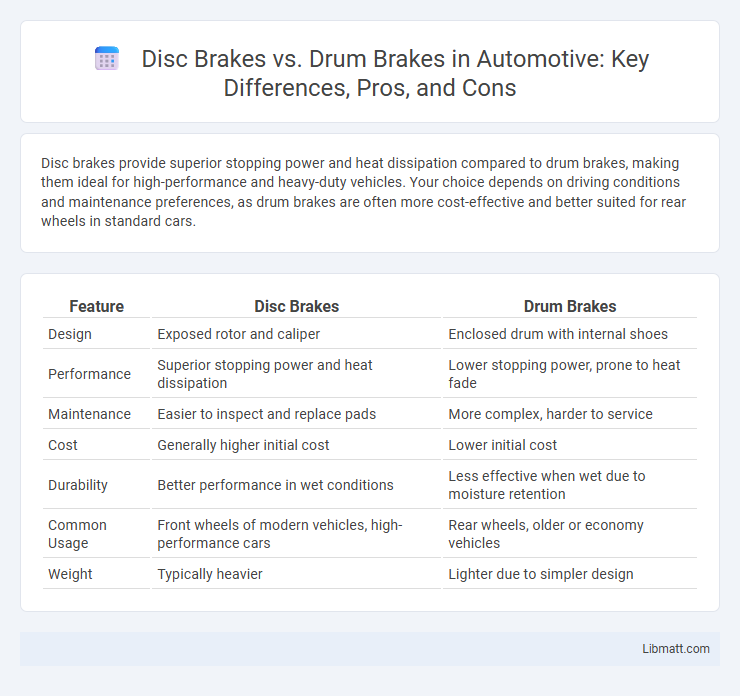Disc brakes provide superior stopping power and heat dissipation compared to drum brakes, making them ideal for high-performance and heavy-duty vehicles. Your choice depends on driving conditions and maintenance preferences, as drum brakes are often more cost-effective and better suited for rear wheels in standard cars.
Table of Comparison
| Feature | Disc Brakes | Drum Brakes |
|---|---|---|
| Design | Exposed rotor and caliper | Enclosed drum with internal shoes |
| Performance | Superior stopping power and heat dissipation | Lower stopping power, prone to heat fade |
| Maintenance | Easier to inspect and replace pads | More complex, harder to service |
| Cost | Generally higher initial cost | Lower initial cost |
| Durability | Better performance in wet conditions | Less effective when wet due to moisture retention |
| Common Usage | Front wheels of modern vehicles, high-performance cars | Rear wheels, older or economy vehicles |
| Weight | Typically heavier | Lighter due to simpler design |
Overview of Disc Brakes and Drum Brakes
Disc brakes feature a rotor attached to the wheel and calipers that squeeze brake pads against the rotor to generate friction, providing superior heat dissipation and consistent stopping power. Drum brakes consist of brake shoes pressing outward against a rotating drum, typically offering lower manufacturing costs but reduced performance under high stress. Disc brakes excel in wet conditions due to their open design, while drum brakes are often used in rear wheels for parking brakes and cost efficiency.
Key Differences Between Disc and Drum Brakes
Disc brakes offer superior heat dissipation and consistent stopping power due to their exposed rotor design, while drum brakes have enclosed components that can retain heat and reduce braking efficiency. Disc brakes provide better performance in wet conditions and are easier to inspect and maintain compared to drum brakes, which tend to be more durable and cost-effective. Understanding these key differences helps you choose the brake system that best suits your vehicle's performance and maintenance needs.
How Disc Brakes Work
Disc brakes operate by using calipers to squeeze pairs of pads against a disc rotor attached to the wheel, creating friction that slows down or stops the vehicle. The hydraulic system in disc brakes provides consistent and efficient stopping power, especially under high-performance or wet conditions. Your vehicle benefits from faster heat dissipation and better braking control compared to drum brakes.
How Drum Brakes Function
Drum brakes function by using brake shoes that press outward against a rotating drum attached to the wheel, creating friction to slow or stop the vehicle. When the brake pedal is pressed, hydraulic fluid forces the shoes to expand and grip the inner surface of the drum. This braking system provides reliable stopping power, especially for rear wheels, but can be prone to heat buildup and reduced performance under heavy use compared to disc brakes.
Performance Comparison: Stopping Power
Disc brakes offer superior stopping power due to better heat dissipation and more consistent friction, making them ideal for high-performance and heavy-duty applications. Drum brakes tend to fade under repeated use because heat gets trapped, reducing their effectiveness in emergency stops. Your safety benefits from disc brakes' reliable performance in both wet and dry conditions, ensuring faster and more controlled stops.
Maintenance and Durability
Disc brakes offer easier maintenance due to their exposed design, allowing for quick inspection and replacement of pads, while drum brakes require more time-consuming disassembly to access internal components. The durability of disc brakes is generally superior since they dissipate heat more efficiently, reducing the risk of brake fade and wear over time compared to drum brakes, which can retain heat and wear unevenly. When considering your vehicle's braking system, choosing disc brakes often results in lower maintenance costs and longer-lasting performance.
Cost Differences: Initial and Long-Term
Disc brakes typically have a higher initial cost due to advanced materials and manufacturing processes, while drum brakes are generally cheaper upfront. Over the long term, disc brakes offer lower maintenance costs and better heat dissipation, reducing wear and replacement frequency, whereas drum brakes may incur more frequent servicing and part replacements. Your choice between disc and drum brakes should weigh initial affordability against ongoing performance and maintenance expenses.
Safety and Reliability
Disc brakes offer superior safety and reliability due to their enhanced heat dissipation, reducing brake fade during prolonged use and maintaining consistent stopping power. Drum brakes, while effective in certain applications, are more prone to overheating and may suffer from reduced performance under heavy or repeated braking conditions. Ensuring your vehicle is equipped with disc brakes can significantly improve your overall braking safety and reliability.
Applications: Where Each Brake Type Is Used
Disc brakes dominate in modern passenger cars, motorcycles, and high-performance vehicles due to their superior heat dissipation and stopping power, which enhances safety and control. Drum brakes are commonly found in trucks, trailers, and older or budget vehicles, favored for their durability and cost-effectiveness in heavy-duty or rear braking applications. Your choice between disc and drum brakes should consider vehicle type, performance needs, and maintenance preferences.
Future Trends in Brake Technology
Disc brakes are rapidly evolving with advancements in materials like carbon-ceramic composites, enhancing heat dissipation and reducing weight for electric and high-performance vehicles. Drum brakes, traditionally used for rear wheels, face limited innovation but remain relevant in cost-sensitive markets due to their simplicity and durability. Future brake technology prioritizes integration with electronic systems for autonomous driving, regenerative braking in EVs, and adaptive safety features to improve overall vehicle efficiency and safety.
Disc brakes vs Drum brakes Infographic

 libmatt.com
libmatt.com